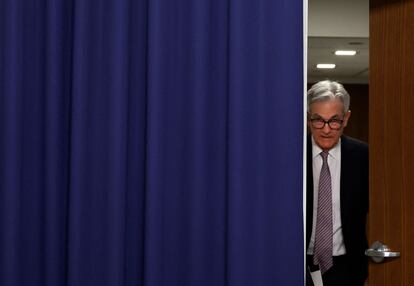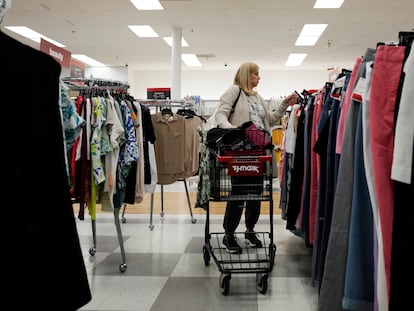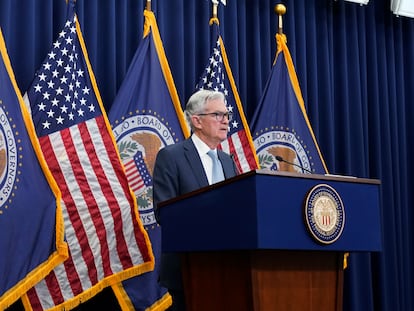Federal Reserve prepares to increase interest rates to highest level since 2001
The U.S. central bank is bumping monetary prices closer to the levels of the dot-com bubble


January 2001. The dot-com bubble had just burst. Stock prices had taken a sharp downturn, and the 1999 and 2000 interest rate increases were putting the U.S. economy on the ropes. A recession was looming. Alan Greenspan, then chair of the Federal Reserve, decided to cut interest rates by 1.5 points, from 6.50% to 5.00%, in the first quarter. Twenty-two years later, today’s chair of the Federal Reserve, Jerome Powell, is preparing to set the highest interest rates in his fight against inflation. The big question is whether he will spark a recession or manage to steer clear of one.
In June, the U.S. central bank softened its most aggressive monetary policy tightening since the 1980s. It hiked rates by 5 points to the current 5%-5.25% range in 10 consecutive increments from March 2022 through to May. Minutes of the Reserve’s last meeting revealed that several members of the monetary policy committee were not in favor of the pause.
A closer look at the report has reinforced the view that the Fed will resume rate rises on July 26, despite the fact that production slowed slightly more than expected in June and that the base effect may knock inflation below 4% as soon as this Wednesday.
“Job growth moderated more than expected in June and there were large downward revisions to payroll gains for the prior two months. However, the slowdown in job growth isn’t enough to prevent a rate hike at the Federal Open Market Committee meeting later this month, particularly given the indicators showing that labor market conditions are slowly easing but remain tight,” said Nancy Vanden Houten, lead U.S. economist at Oxford Economics, in a note on Friday.
“We expect the Fed to raise rates twice more, by 25bp each, in July and September,” added Ethan Harris, Head of Global Economics at the Bank of America.
One of these 0.25 percentage-point increases would suffice to go beyond the 5.25% of 2007, with the bursting of another bubble, this time in real estate. The 2000-2001 and 2006-2007 period were the last years in which interest rates were over 5%, and in both cases a recession ensued. The question remains, will history repeat itself or will Powell succeed in emulating Greenspan? The latter succeeded in achieving the sought-after soft landing in 1994.
For now, the recession is yet to materialize. “I’ve been hearing every month that there’s going to be a recession next month,” U.S. President Joe Biden said in late June. “I don’t think will will [have one],” he added.
Most economists have increasingly pushed back the moment of recession. Experts at the Bank of America acknowledge that “the recent data flow has surprised to the upside,” but still insist that the downturn is coming. “The housing sector appears to be finding a bottom, and auto sales and production have rebounded as supply constraints have eased. Although these rates-sensitive sectors have outperformed expectations and the broader economy is growing around trend, we still think there are enough pockets of concern that a mild recession, starting in the first half of 2024, should be the base case,” said Harris, the bank’s chief U.S. economist.
The Bank of America pointed out that it does not believe that the minor rate hikes that are still expected will prove to be the tipping point. “We think the U.S. economy has not yet felt the full impact of the 500 basic points of rate increases since last March.” They note that in the run-up to the financial crisis, when there were considerably greater imbalances in the economy, the Fed stopped increasing rates in June 2006. Yet, the recession did not start until a year-and-a-half later.
Fed experts also consider the recession to be the baseline scenario. Their view is that the effects of the expected re-tightening of bank credit conditions, amid the already stringent financial conditions, will trigger a mild recession starting at the end of this year, followed by a recovery at a moderate pace. The technical services advising the monetary policy committee forecasted a deceleration of real GDP in the second quarter and third quarter of this year, prior to a modest decline in both the fourth quarter and the first quarter of next year.
That said, the experts concede that uncertainty is running high. Indeed, the big difference in the latest published minutes compared to previous meetings is the admission that “Given the continued strength in labor market conditions and the resilience of consumer spending, however, the staff saw the possibility of the economy continuing to grow slowly and avoiding a downturn as almost as likely as the mild‑recession baseline.”
In his memoirs, Alan Greenspan, who chaired the Federal Reserve from 1987 to 2006, cites one of his greatest successes as his achievement of the long-desired soft landing with the 1994 rate increases. He explains that the term was not even in use at the Fed at the time, but it was a term derived from the space race between the U.S. and the Soviet Union in the 1970s. Greenspan attempted to repeat the maneuver in 2000-2001, but was unable to avoid recession.
However, Powell’s reference is not Greenspan, but his predecessor, Paul Volcker. “Who isn’t an admirer of Paul Volcker? I shouldn’t be singled out in this respect. But I knew him just a little bit and have tremendous admiration for him,” he replied when asked about him in May last year, stressing that the former chairman of the Federal Reserve from 1979 to 1987 “had the courage to do what he thought was the right thing to do.” He did beat inflation at the cost of triggering a recession and Powell is ready to emulate him.
Sign up for our weekly newsletter to get more English-language news coverage from EL PAÍS USA Edition
Tu suscripción se está usando en otro dispositivo
¿Quieres añadir otro usuario a tu suscripción?
Si continúas leyendo en este dispositivo, no se podrá leer en el otro.
FlechaTu suscripción se está usando en otro dispositivo y solo puedes acceder a EL PAÍS desde un dispositivo a la vez.
Si quieres compartir tu cuenta, cambia tu suscripción a la modalidad Premium, así podrás añadir otro usuario. Cada uno accederá con su propia cuenta de email, lo que os permitirá personalizar vuestra experiencia en EL PAÍS.
¿Tienes una suscripción de empresa? Accede aquí para contratar más cuentas.
En el caso de no saber quién está usando tu cuenta, te recomendamos cambiar tu contraseña aquí.
Si decides continuar compartiendo tu cuenta, este mensaje se mostrará en tu dispositivo y en el de la otra persona que está usando tu cuenta de forma indefinida, afectando a tu experiencia de lectura. Puedes consultar aquí los términos y condiciones de la suscripción digital.
More information
Archived In
Últimas noticias
Most viewed
- Oona Chaplin: ‘I told James Cameron that I was living in a treehouse and starting a permaculture project with a friend’
- Reinhard Genzel, Nobel laureate in physics: ‘One-minute videos will never give you the truth’
- Sinaloa Cartel war is taking its toll on Los Chapitos
- Why the price of coffee has skyrocketed: from Brazilian plantations to specialty coffee houses
- Chevy Chase, the beloved comedian who was a monster off camera: ‘Not everyone hated him, just the people who’ve worked with him’










































